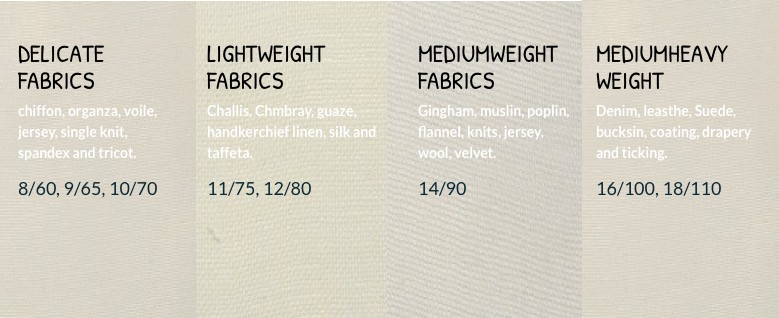Satin vs Sateen
In the vast panorama of textiles available to retailers, designers, and creators, two materials often stand out for their unique […]
Secure Payments
Over 450 fabrics with large stock availability!
To make sewers lives much easier, sewing machine needles are standardised, meaning whatever ones you purchase, they will be compatible with your brand of sewing machine. When it comes to choosing the type of needle, it’s a case of matching it with the type of fabric and its weight. Once you understand how needle types relate to the fabric’s structure, you’ll wonder why you never changed your needles sooner.
This type of needle is the most common and is probably the one you’ve been using, as many sewing machines come with a starter set of these. They have a slightly rounded tip, and sew well with woven fabrics, cotton, silk, and some knit fabrics.
A ball point needle is slightly more rounded than a universal needle, changing the way it works with the fibres. They push between the fabric fibres, and ideal to use with knit and stretch fabrics such as rib knots, cotton knits and fleece.
Stretch needles also have a ball point tip, however they have a distinctive eye and scarf for stretchy fabrics that are hard to sew. Material such as Lycra, spandex, and elastic should be used with this needle for the best results.
Sharp needles are perfect for woven fabrics as they tend not to pucker and produce an even stitch. They also work well with several layers of the right fabric type due to its strong shaft. We wouldn’t recommend using this type of needle with knit fabrics as they can cause missed stitches.
The reinforced shaft on a quilting needles means they can be easily used with a few layers of fabric and wadding. Their shortness in length gives you the opportunity to achieve a quick and even stitch, especially when sewing with cotton fibres.
Designed with a wider eye, embroidery needles accommodate thicker threads such as polyester or cotton. They create intricate designs at a fast pace, without snagging the fabric of breaking the needle.
A leather needle is shaped like a spear to cut through the leather whilst forming the stitch. They are sometimes referred to as a chisel point needle and should only be used with genuine leather and suede. You should avoid using this type of needle imitation leather or suede as their fibres are quite different to the real deal.
As the name suggests, this needle is designed for working with denim. A jean needle has a sharp point and stronger shank to push through the fabric and prevent the needle from breaking. They are also suitable for other dense fabrics such as heavy twill, canvas and dense linens.
A top stitch needle has a larger eye and deeper groove, which makes it perfect to use with heavier topstitching thread. It will pierce through many different types of fabrics and can give your project a distinctive finish.
Understanding the size of needle you should be using is just as important as knowing what type. Two sizes are often shown on needle packs, American sizes range from 8 to 19, whilst European sizes range from 60 to 120.The general rule is the smaller the number, the thinner the needle and this should correspond to the weight of the fabric.
